Search
- Page Path
-
- HOME
- Search
- Review Article
- Gastroenterology
- Current diagnosis and image-guided reduction for intussusception in children
- Jisun Hwang, Hee Mang Yoon, Pyeong Hwa Kim, Ah Young Jung, Jin Seong Lee, Young Ah Cho
- Clin Exp Pediatr. 2023;66(1):12-21. Published online July 4, 2022
-

· Intussusception, the most common cause of small bowel obstruction in young children, has an overall incidence in Korea of 28.3 cases per 100,000 person-years.
· Its cause is idiopathic inmost cases, although viral or bacterial gastroenteritis has beenpostulated as a cause. Approximately 4% of children have pathological lead points for intussusception, and Meckel’s diverticulum is the most common cause.
· Intussusception in preterm infants is extremely rare. Older children (>5 years of age) are at increased risk of pathological lead points.
- Infection
- Therapeutics for the treatment of coronavirus disease 2019 in children and adolescents
- Soo-Han Choi, Jae Hong Choi, Ki Wook Yun
- Clin Exp Pediatr. 2022;65(8):377-386. Published online June 27, 2022
-
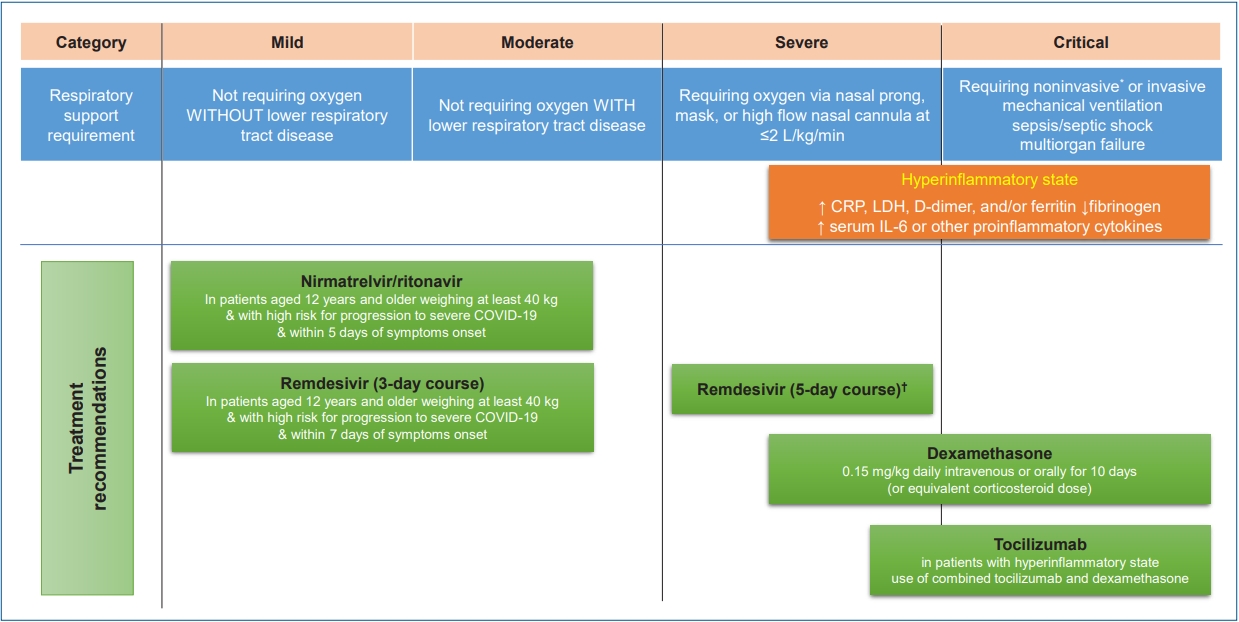
· Children and adolescents with high risks for severe coronavirus disease 2019 (COVID-19) should be identified and proper treatment should be provided promptly according to the patient’s condition.
· Remdesivir can be considered for pediatric patients of all ages with COVID-19 who have an emergent or increase in supplemental oxygen.
· The use of corticosteroids is not recommended for patients with nonsevere COVID-19. Corticosteroids are recommended in children and adolescents with severe and critical COVID-19.
- Neurobehavior
- Jeopardized mental health of children and adolescents in coronavirus disease 2019 pandemic
- Bohyun Jin, Sohee Lee, Un Sun Chung
- Clin Exp Pediatr. 2022;65(7):322-329. Published online June 3, 2022
-

∙ The coronavirus disease 2019 (COVID-19) pandemic has required preventive measures like self-quarantine, school closures, and lockdown, which ultimately make youth directly and indirectly vulnerable to depression, anxiety, posttraumatic stress disorder, and somatization.
∙ Child abuse is more common in the COVID-19 era than previously.
∙ Pediatricians should carefully examine parental and child mental health to directly and indirectly aid their physical and mental health.
- Original Article
- Neurology
- Neurodevelopmental outcomes and comorbidities of children with congenital muscular torticollis: evaluation using the National Health Screening Program for Infants and Children database
- Og Hyang Kim, Seung Won Lee, Eun Kyo Ha, Ju Hee Kim, Yun Hye Jo, Seongyeong Rhie, Man Yong Han, Kyu Young Chae
- Clin Exp Pediatr. 2022;65(6):312-319. Published online December 9, 2021
-

Question: What comorbidities are increased in children with congenital muscular torticollis (CMT)? Are there differences in the neurodevelopmental outcomes of children with CMT who received physical therapy versus those who did not?
Finding: The risk of congenital musculoskeletal deformities is increased in CMT. Children who did not receive physical therapy were at greater risk of neurodevelopmental delay.
Meaning: In CMT, musculoskeletal comorbidities should be identified and active early treatment provided.
- Cardiology
- Early myocardial functional abnormalities in primary dyslipidemia: clinical and echocardiographic observations in young children from a highly consanguineous population
- Nehal M. El-koofy, Aya M. Fattouh, Areef Ramadan, Mohamed A. Elmonem, Dina H. Hamed
- Clin Exp Pediatr. 2022;65(8):410-416. Published online December 8, 2021
-
In children with primary dyslipidemia, functional myocardial abnormalities can occur at young age, including diastolic functional impairment of both ventricles and narrowing of the aortic valve and the sinus of Valsalva. Echocardiographic evaluations of high-risk children may be as important as biochemical evaluations.
- Review Article
- Endocrinology
- Pediatric hypertension based on Japanese Society of Hypertension Guidelines (JSH 2019) with actual school blood pressure screening data in Japan
- Toru Kikuchi
- Clin Exp Pediatr. 2022;65(6):283-290. Published online November 26, 2021
-
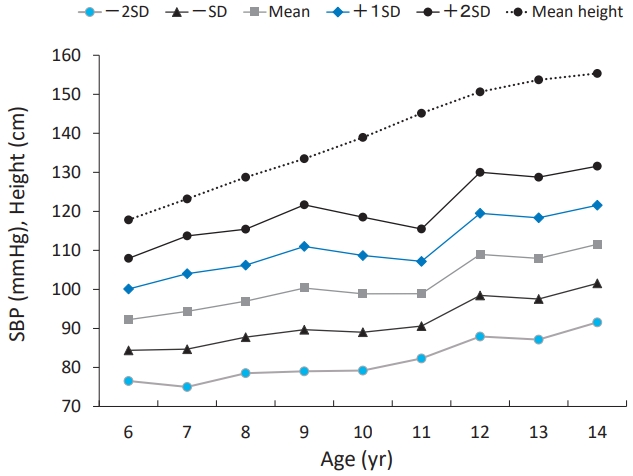
The prevalence of Japanese pediatric hypertension is 0.9% based on proper measurement protocols. Hypertensive children tend to be hypertensive adults. Pediatric essential hypertension is characterized by an absence of symptoms, obesity, a family history of hypertension, and a low birth weight. The most common causes of pediatric secondary hypertension are renal parenchymal and renovascular diseases. Important factors controlling pediatric hypertension include healthy lifestyle modifications and pharmacotherapy.
- Original Article
- Developmental and Behavioral Medicine
- Effectiveness of obesity interventions among South Korean children and adolescents and importance of the type of intervention component: a meta-analysis
- Siyoung Choe, Jaesin Sa, Jean-Philippe Chaput, Deokjin Kim
- Clin Exp Pediatr. 2022;65(2):98-107. Published online November 23, 2021
-
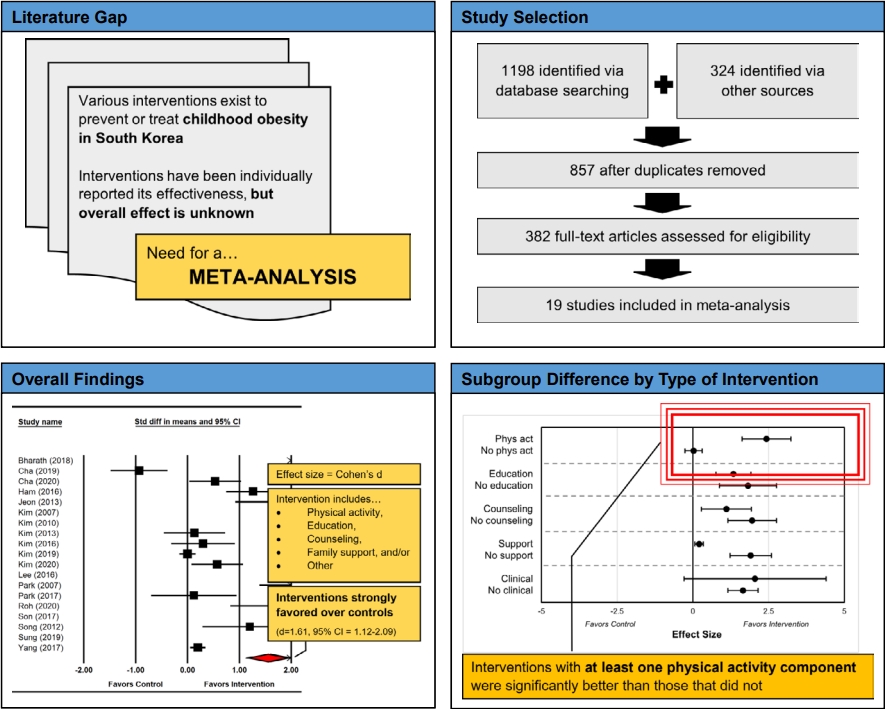
Question: What is the overall effect of obesity interventions among Korean children and what affects their effectiveness?
Finding: Interventions were strongly favored over controls. Interventions including at least one physical activity component were significantly better than those that did not. Sex, age, baseline weight category, intervention duration, and the number of intervention components were not significant.
Meaning: Future obesity interventions for Korean children must seek to include physical activity components.
- Review Article
- Infection
- Four months of rifampicin monotherapy for latent tuberculosis infection in children
- Chi Eun Oh, Dick Menzies
- Clin Exp Pediatr. 2022;65(5):214-221. Published online October 29, 2021
-
· Recently, the importance of a short-term treatment regimen including rifamycin has been highlighted in the treatment of latent tuberculosis infection (LTBI).
· Four prospective or retrospective studies in children consistently reported that a 4-month daily rifampicin regimen (4R) had a higher completion rate than and comparable safety to a nine-month daily isoniazid regimen.
· We suggest rifampicin 20–30 mg/kg/day for children aged 0–2 years and 15–20 mg/kg/day for children aged 2–10 years in 4R to treat LTBI.
- Original Article
- Infection
- Viral load and rebound in children with coronavirus disease 2019 during the first outbreak in Daegu city
- Mi Ae Chu, Yoon Young Jang, Dong Won Lee, Sung Hoon Kim, Namhee Ryoo, Sunggyun Park, Jae Hee Lee, Hai Lee Chung
- Clin Exp Pediatr. 2021;64(12):652-660. Published online October 12, 2021
-
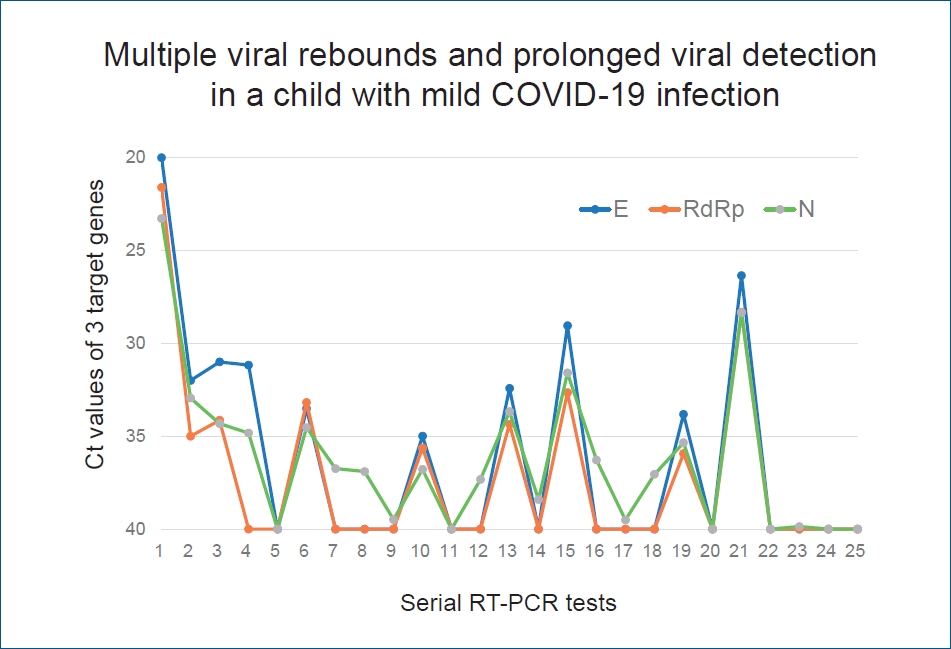
Question: What is the natural course of viral load in children with coronavirus disease 2019 (COVID-19)?
Finding: A significant number of patients still had a relatively high viral load once clinically asymptomatic. Nearly half of the patients experienced viral rebound, which contributed to prolonged viral detection in their respiratory specimens.
Meaning: Further studies are needed to determine the clinical significance of viral rebound in asymptomatic or mild pediatric cases of COVID-19.
- Review Article
- Nephrology (Genitourinary)
- Blood pressure measurements and hypertension in infants, children, and adolescents: from the postmercury to mobile devices
- Seon Hee Lim, Seong Heon Kim
- Clin Exp Pediatr. 2022;65(2):73-80. Published online September 15, 2021
-

· Hypertension is defined as a blood pressure (BP) >90th (elevated) or 95th (hypertension) percentile in children by height, age, and sex and >95th percentile in neonates by age, birth weight, and sex.
· Although the oscillometric method can be used for screenings, the auscultatory method remains the gold standard. The hybrid method employs the auscultatory and electronic methods and can reduce bias.
· BP measurement mobile device applications have a potential for development.
- Original Article
- Emergency Medicine
- Nonfatal injuries in Korean children and adolescents, 2007–2018
- Gyu Min Yeon, Yoo Rha Hong, Seom Gim Kong
- Clin Exp Pediatr. 2022;65(4):194-200. Published online September 9, 2021
-
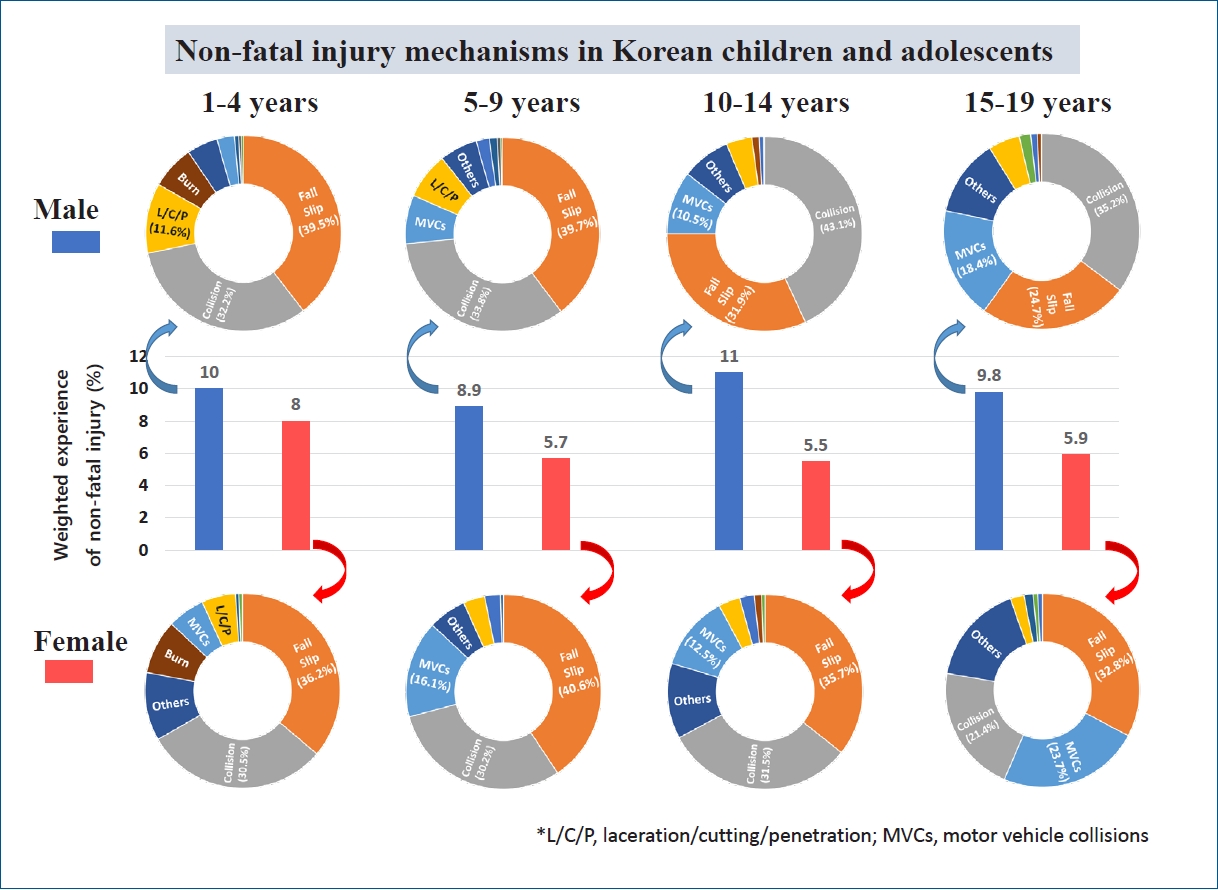
Question: How many children and adolescents have experienced nonfatal injuries in the previous year?
Finding: Among Korean children and adolescents, 8.1% experienced at least one injury per year. We found no significant change in the incidence of injuries over the previous 12 years.
Meaning: The incidence of injuries is higher than this estimation; therefore, more attention and effort are needed to prevent injuries among children and adolescents.
- Review Article
- Endocrinology
- Endocrine comorbidities of pediatric obesity
- Jieun Lee, Jae Hyun Kim
- Clin Exp Pediatr. 2021;64(12):619-627. Published online August 26, 2021
-

∙ Pediatric obesity can involve endocrine comorbidities such as prediabetes, type 2 diabetes, dyslipidemia, metabolic syndrome, polycystic ovary syndrome, and central precocious puberty.
∙ Prediabetes and type 2 diabetes in youth aged 10–19 years had a prevalence of 25.9% and 0.6% in 2013–2014, respectively.
∙ Dyslipidemia in Korean adolescents aged 10–18 years had a prevalence of 7.64% (total cholesterol ≥200 mg/dL), 6.09% (low-density lipoprotein cholesterol ≥130 mg/dL), 8.69% (triglyceride ≥150 mg/dL), and 12.52% (high-density lipoprotein cholesterol ≤40 mg/dL) in 2007–2018.
∙ Metabolic syndrome in Korean youth has a prevalence of 1.9%–14.7% in males and 1.7%–12.6% in females with wide variation in definitions.
∙ Appropriate comorbidity screening and management and/or specialist referral are necessary for obese children and adolescents.
- Original Article
- Other
- Clinical spectrum and short-term outcomes of multisystem inflammatory syndrome in children in a south Indian hospital
- Muruganantham Balagurunathan, Thrilok Natarajan, Jothilakshmi Karthikeyan, Venkateshwaran Palanisamy
- Clin Exp Pediatr. 2021;64(10):531-537. Published online August 4, 2021
-

Question: What are the clinical spectrum, course, and short-term outcomes of multisystem inflammatory syndrome in children (MIS-C)?
Finding: MIS-C can have variable clinical manifestations. Fever is most common, followed by gastrointestinal and cardiovascular symptoms. Early identification and appropriate management lead to favorable outcomes.
Meaning: MIS-C can present in a myriad of ways and severities. High suspicion is necessary to ensure its early identification and appropriate management and favorable patient outcomes.
- Review Article
- Infection
- School closures during the coronavirus disease 2019 outbreak
- Eun Young Cho, Young June Choe
- Clin Exp Pediatr. 2021;64(7):322-327. Published online May 31, 2021
-
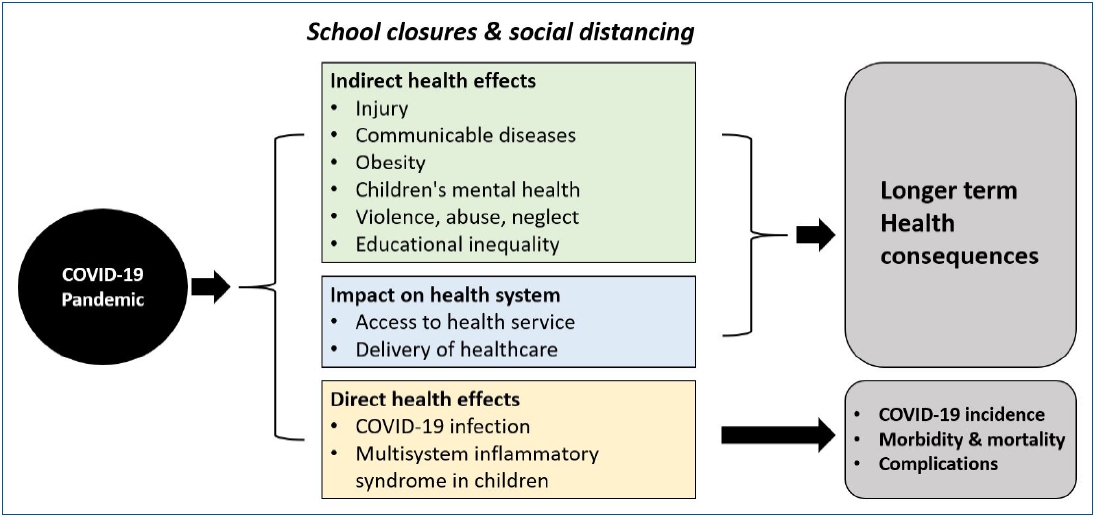
· Earlier modeling studies of the effects of school closures on severe acute respiratory syndrome coronavirus 2 were largely derived from the pandemic influenza model, resulting in conflicting implications.
· Observational findings suggest no clear effect of school closures on community transmission or overall mortality.
· School closures must be weighed against potential high social costs, which can also negatively affect children’s health.
- Original Article
- Emergency Medicine
- Comparison of clinical features and laboratory findings of coronavirus disease 2019 and influenza A and B infections in children: a single-center study
- Meraj Siddiqui, Ayşe Gültekingil, Oğuz Bakırcı, Nihal Uslu, Esra Baskın
- Clin Exp Pediatr. 2021;64(7):364-369. Published online May 18, 2021
-
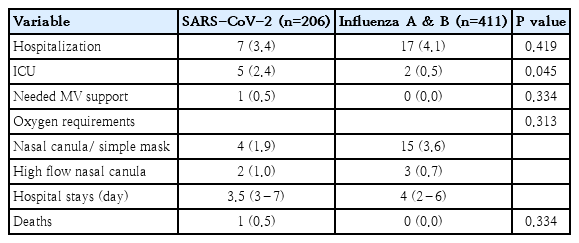
Question: What are the differences between coronavirus disease 2019 (COVID-19) and influenza infections in children?
Finding: Pediatric COVID-19 patients predominantly exhibited respiratory and/or gastrointestinal symptoms, neurological manifestations, olfactory/gustatory dysfunction, elevated monocytes, mildly elevated C-reactive protein, and unilateral or diffuse abnormalities on chest x-ray. Patients with underlying medical conditions had higher intensive care unit admission rates and should be followed closely.
Meaning: The clinical presentations of pediatric COVID-19 patients varied from asymptomatic/mild to severe.
- General Pediatrics
- Effect of maternal and child factors on stunting: partial least squares structural equation modeling
- Agus Santosa, Essa Novanda Arif, Dinal Abdul Ghoni
- Clin Exp Pediatr. 2022;65(2):90-97. Published online May 4, 2021
-
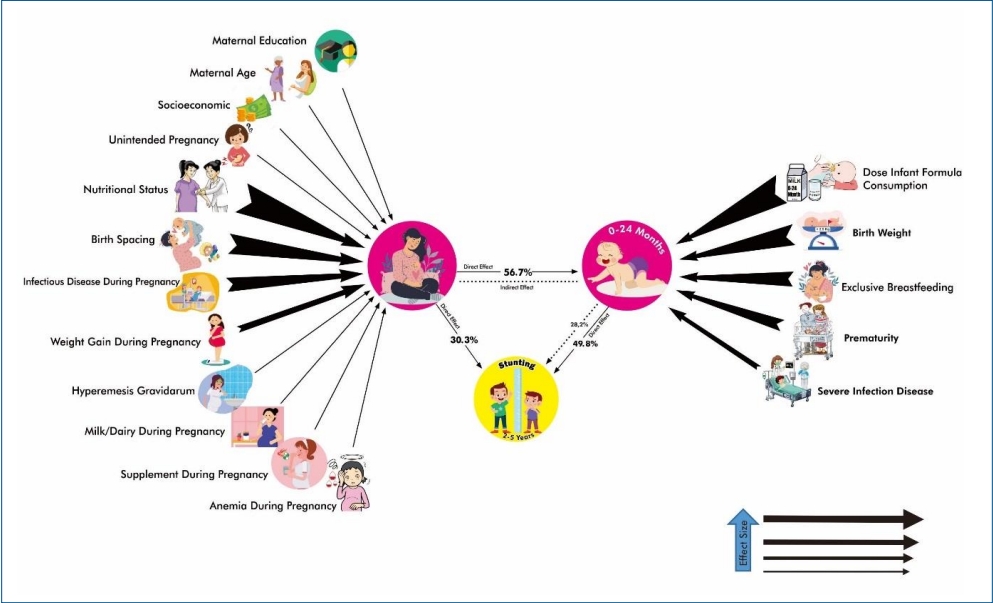
Question: What effects do maternal and child factors have on stunting? Are there significant indicators of stunting?
Finding: Child and maternal factors had 49.8% and 30.3% effects on stunting, respectively. The primary child factor was infant formula dose, while the primary maternal factor was nutritional status.
Meaning: More attention to nutritional status during pregnancy and ensuring the appropriate dose of infant formula at ages 6–24 months can prevent stunting.
- Global relationship between parent and child obesity: a systematic review and meta-analysis
- Ju Suk Lee, Mi Hyeon Jin, Hae Jeong Lee
- Clin Exp Pediatr. 2022;65(1):35-46. Published online March 29, 2021
-

Question: Are parent and child obesity correlated worldwide?
Finding: Overweight and obese status of parents and children were significantly associated worldwide. The association between parent and child obesity was stronger in Asia than in Europe and the Middle East, and in high-income than in middle- and low-income countries.
Meaning: Childhood obesity is highly influenced by parental weight status, indicating that parents could play an important role in its prevention.
- Cardiology
- Assessment of cardiac function in syncopal children without organic causes
- Heoungjin Kim, Lucy Youngmin Eun
- Clin Exp Pediatr. 2021;64(11):582-587. Published online March 10, 2021
-

Question: Does a subtle deterioration in cardiac function affect the severity of syncope in patients without underlying disease?
Finding: For syncope patients with reasonable cardiac function but without underlying disease, tissue Doppler imaging (TDI) measurements helped reveal subtle differences in cardiac function with syncope and predicted the severity of syncope or a potential recurrent event.
Meaning: TDI measurements might be a useful indicator for predicting the severity of syncope.
- Review Article
- Cardiology
- Application of CRISPR-Cas9 gene editing for congenital heart disease
- Heeyoung Seok, Rui Deng, Douglas B. Cowan, Da-Zhi Wang
- Clin Exp Pediatr. 2021;64(6):269-279. Published online March 2, 2021
-
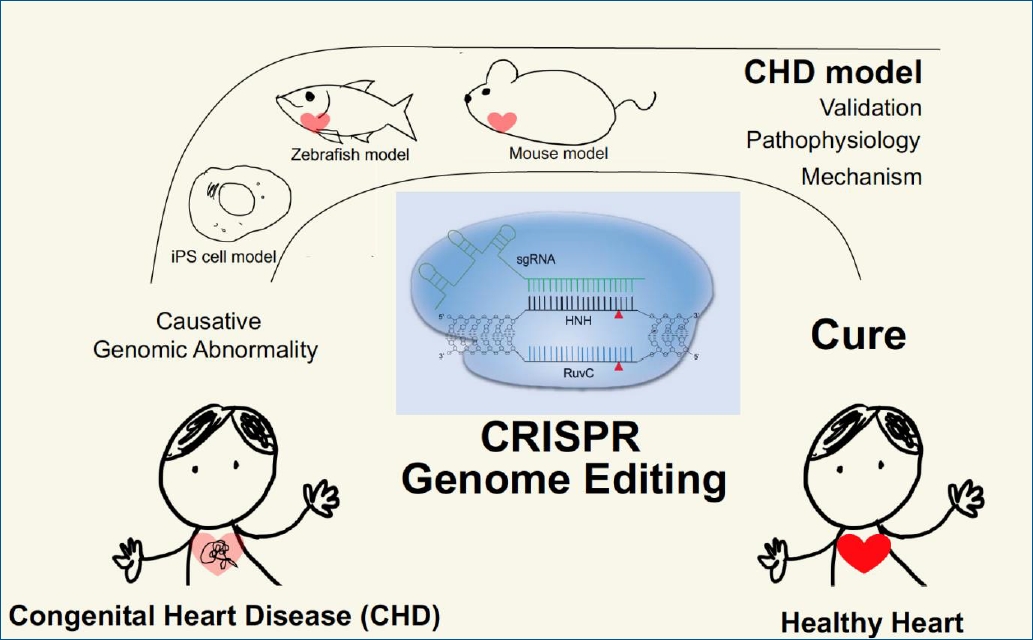
Clustered regularly interspaced short palindromic repeats and CRISPR-associated protein 9 (CRISPR-Cas9) system has made a big step in the genome editing which still requires technical developments for the efficient applications in the many fields including congenital heart diseases (CHDs), closely related to the genomic abnormality. In this review, we tried to cover the most updated researches of CRISPR-Cas9 in the CHDs to understand the current technologies, eventually becoming therapeutic bases for the CHD patients.
- Infection
- Consideration in treatment decisions for refractory Mycoplasma pneumoniae pneumonia
- Hye-Kyung Cho
- Clin Exp Pediatr. 2021;64(9):459-467. Published online February 10, 2021
-

• To avoid unnecessary exposure to secondary antibiotics, it is needed to diagnose Mycoplasma pneumoniae (MP) pneumonia carefully, especially when unresponsiveness to macrolide is suspected.
• Serologic and molecular tests for MP infection and excluding respiratory infection caused by other pathogens might be considered.
• It is necessary to continuously monitor antibiotic susceptibility of MP, and efforts to lower antibiotic pressure are required.
- Allergy
- Eosinophils and childhood asthma
- Bong Seok Choi
- Clin Exp Pediatr. 2021;64(2):60-67. Published online January 6, 2021
-
•In allergic eosinophilic asthma, eosinophils act as important effector cells and antigen-presenting cells, while in nonallergic eosinophilic asthma, type 2 innate lymphoid cells play an important role in eosinophil activation.
•Sputum eosinophil counts can be helpful for evaluating allergic airway inflammation in asthma.
• Anti-interleukin-5 has broadened the scope of asthma treatment.
- Original Article
- Allergy
- Cohort profile: National Investigation of Birth Cohort in Korea study 2008 (NICKs-2008)
- Ju Hee Kim, Jung Eun Lee, So Min Shim, Eun Kyo Ha, Dong Keon Yon, Ok Hyang Kim, Ji Hyeon Baek, Hyun Yong Koh, Kyu Young Chae, Seung Won Lee, Man Yong Han
- Clin Exp Pediatr. 2021;64(9):480-488. Published online January 5, 2021
-
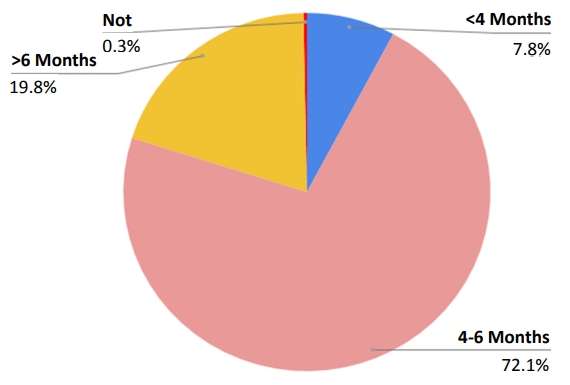
This national cohort study included all Korean children born in 2008 and 2009 observed over a period of more than 10 years. Our findings demonstrate that it is possible to analyze disease onset prior to hospitalization based on information such as lifestyle, eating habits, and risk factors by integrating National Health Insurance System data with national health screening data.
- Review Article
- General Pediatrics
- Clinical features, diagnosis, and outcomes of multisystem inflammatory syndrome in children associated with coronavirus disease 2019
- Ji Hee Kwak, Soo-Young Lee, Jong-Woon Choi; the Korean Society of Kawasaki Disease
- Clin Exp Pediatr. 2021;64(2):68-75. Published online December 30, 2020
-

Hundreds of cases of children and adolescents with hyperinflammatory responses such as Kawasaki disease have been reported amid the coronavirus disease 2019 (COVID-19) pandemic, leading to coining of the new term COVID-19–associated multisystem inflammatory syndrome in children. In this review article, we introduce the illness and describe its case definitions, epidemiology, pathogenesis, clinical features, treatments, and outcomes.
- Nutrition
- Dietary intake and nutritional status of Korean children and adolescents: a review of national survey data
- Minji Kang, So Yoon Choi, Minyoung Jung
- Clin Exp Pediatr. 2021;64(9):443-458. Published online December 28, 2020
-
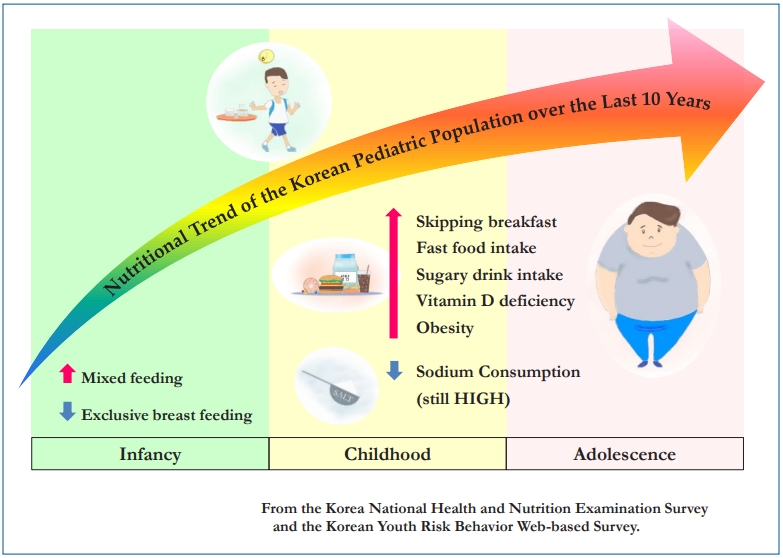
In Korea, several national cross-sectional surveys monitor the diet, nutritional status, and health status of children. This continual dedicated national surveillance system contributes to the identification of nutritional and health issues, establishment of public health policies, and development of nutrition recommendations. This paper provides recent information about the Korea National Health and Nutrition Examination Survey and the Korean Youth Risk...
- Critical Care Medicine
- Pediatric postintensive care syndrome: high burden and a gap in evaluation tools for limited-resource settings
- Chanapai Chaiyakulsil, Rapee Opasatian, Paweethida Tippayawong
- Clin Exp Pediatr. 2021;64(9):436-442. Published online December 18, 2020
-
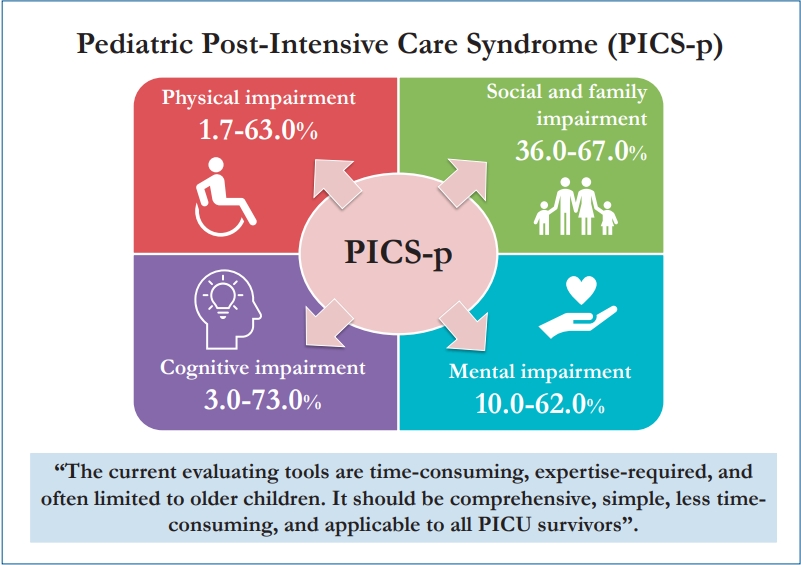
Pediatric postintensive care syndrome has high impact and burden and can affect a child’s life for decades. The early evaluation and detection of such problems require a simple and less time-consuming surveillance tool. Current evaluation tools can be difficult and strenuous for areas with limited resources. Thus, a new simple tool is required for the early detection and intervention of postintensive care syndrome in critically ill children
- Guideline
- Endocrinology
- 2017 Clinical practice guidelines for dyslipidemia of Korean children and adolescents
- Jung Sub Lim, Eun Young Kim, Jae Hyun Kim, Jae-Ho Yoo, Kyung Hee Yi, Hyun Wook Chae, Jin-Ho Choi, Ji Young Kim, Il Tae Hwang; the Committee of Dyslipidemia of Korean Children and Adolescents on behalf of Korean Society of Pediatric Endocrinology (KSPE)
- Clin Exp Pediatr. 2020;63(12):454-462. Published online November 25, 2020
-
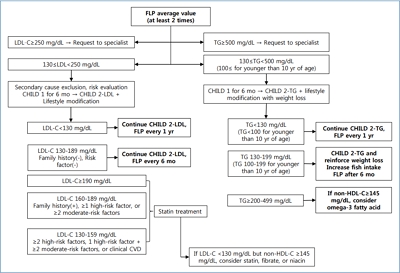
Question: How are children and adolescents with dyslipidemia treated and managed in Korea?
Finding: 2017 guidelines recommend to measure nonfasting non-HDL-C as a screening test and introduce new diet methods: Cardiovascular Health Integrated Lifestyle Diet (CHILD)-1, CHILD-2-low-density lipoprotein cholesterol, and CHILD-2-triglyceride. Statin is the only drug approved in children older than 10 years.
Meaning: New clinical practice guidelines for treating and managing dyslipidemia of Korean children and adolescents are provided.
- Original Article
- Infection
- Prevalence of methicillin-resistant Staphylococcus aureus in Iranian children: a systematic review and meta-analysis
- Farhad Sarrafzadeh, Seyed Mojtaba Sohrevardi, Hamid Abousaidi, Hossein Mirzaei
- Clin Exp Pediatr. 2021;64(8):415-421. Published online November 20, 2020
-

The pooled prevalence of methicillin-resistant Staphylococcus aureus (MRSA) was 42% among culture-positive cases of S. aureus, 51% in hospitalized children, and 14% in healthy children. The high prevalence of MRSA in Iranian children may be due to insufficient infection control measures in hospitals, inappropriate use of methicillin, inadequate staff training, and over-prescription of antibiotics in Iran.
- Review Article
- Infection
- The COVID-19 pandemic: an unprecedented tragedy in the battle against childhood obesity
- Maximilian Andreas Storz
- Clin Exp Pediatr. 2020;63(12):477-482. Published online November 5, 2020
-

Large-scale quarantine and home confinement during the coronavirus disease 2019 (COVID-19) pandemic will impose new and unfamiliar stressors on children, thereby worsening the childhood obesity epidemic. Physical, nutritional, and psychosocial factors that promote obesity in children during this special situation complementarily contribute to an unprecedented obesogenic environment. Involved stakeholders, including governments, schools, and families, must make all efforts to minimize the impact of the COVID-19 epidemic on childhood obesity.
- Original Article - Clinical trial
- WITHDRAWN:Randomized controlled trial of effect of N-acetylcysteine as an antioxidant on iron overload in children with thalassemia major
- Yasmen A Mohamed, Mohamed H Meabed, Amany Ashraf, Dalia S Morgan, Mostafa G Abdul Latif, Rehab M Abd-Elkareem, Heba M Ahmed
-
Background: β-Thalassemias are characterized by the presence of mutations in the globin gene that result in the absence or reduced synthesis of β-globin chains of the hemoglobin tetramer. Several studies have reported increased oxidative stress in β-thalassemia major (β-TM) patients. N-acetylcysteine (NAC), a derivative of L-cysteine amino acid, is commonly used as a mucolytic drug. Numerous studies have reported efficient... -
- Original Article
- Allergy
- Influence of age at complementary food introduction on the development of asthma and atopic dermatitis in Korean children aged 1–3 years
- Jihyun Lee, Meeyong Shin, Bora Lee
- Clin Exp Pediatr. 2021;64(8):408-414. Published online November 1, 2020
-

Question: Is age at the time of complementary food introduction associated with asthma and atopic dermatitis (AD) in early childhood?
Finding: We found no significant association between age at the time of complementary food introduction and the incidence of AD and asthma in Koreans aged 1–3 years.
Meaning: Our findings suggest that the influence of individual allergenic foods on the development of AD and asthma should be clarified.
-

-
-
8.02023CiteScore94th percentilePowered by
-
Impact Factor3.2
-
- TOPICS
- ARTICLE CATEGORY
- Editorial Office
-
Korean Pediatric Society
#1606 Seocho World Officetel, 19 Seoun-ro, Seocho-ku, Seoul 06732, Korea
Tel: +82-2-3473-7306 Fax: +82-2-3473-7307 E-mail: office@e-cep.org
Clinical and Experimental Pediatrics is an open access journal. All articles are distributed under the terms of the Creative Commons Attribution NonCommercial License (http://creativecommons.org/licenses/by-nc/4.0/)
Copyright © 2025 by Korean Pediatric Society.











